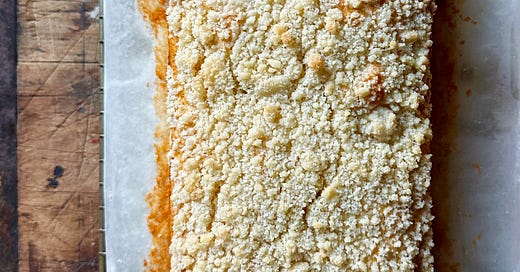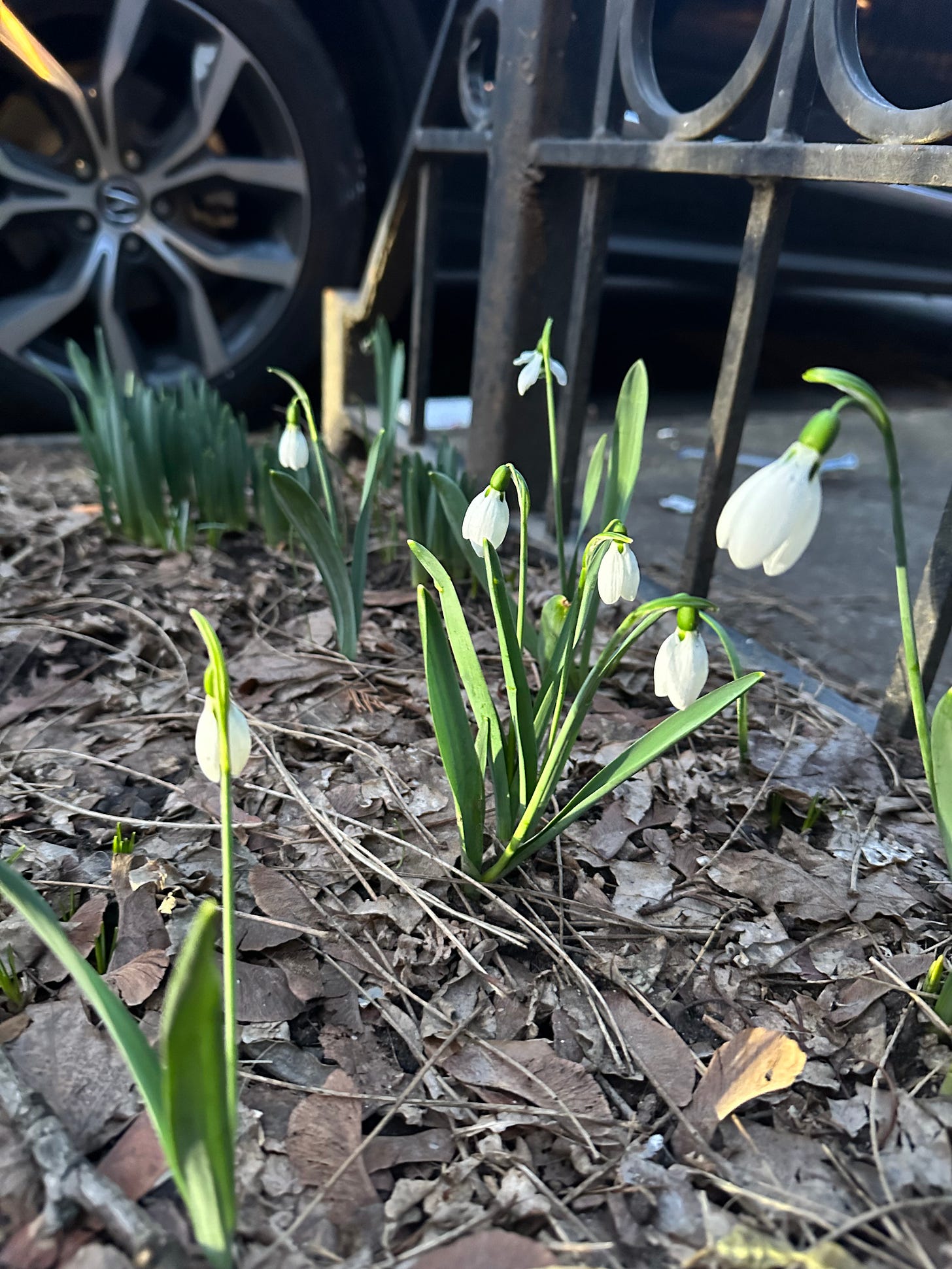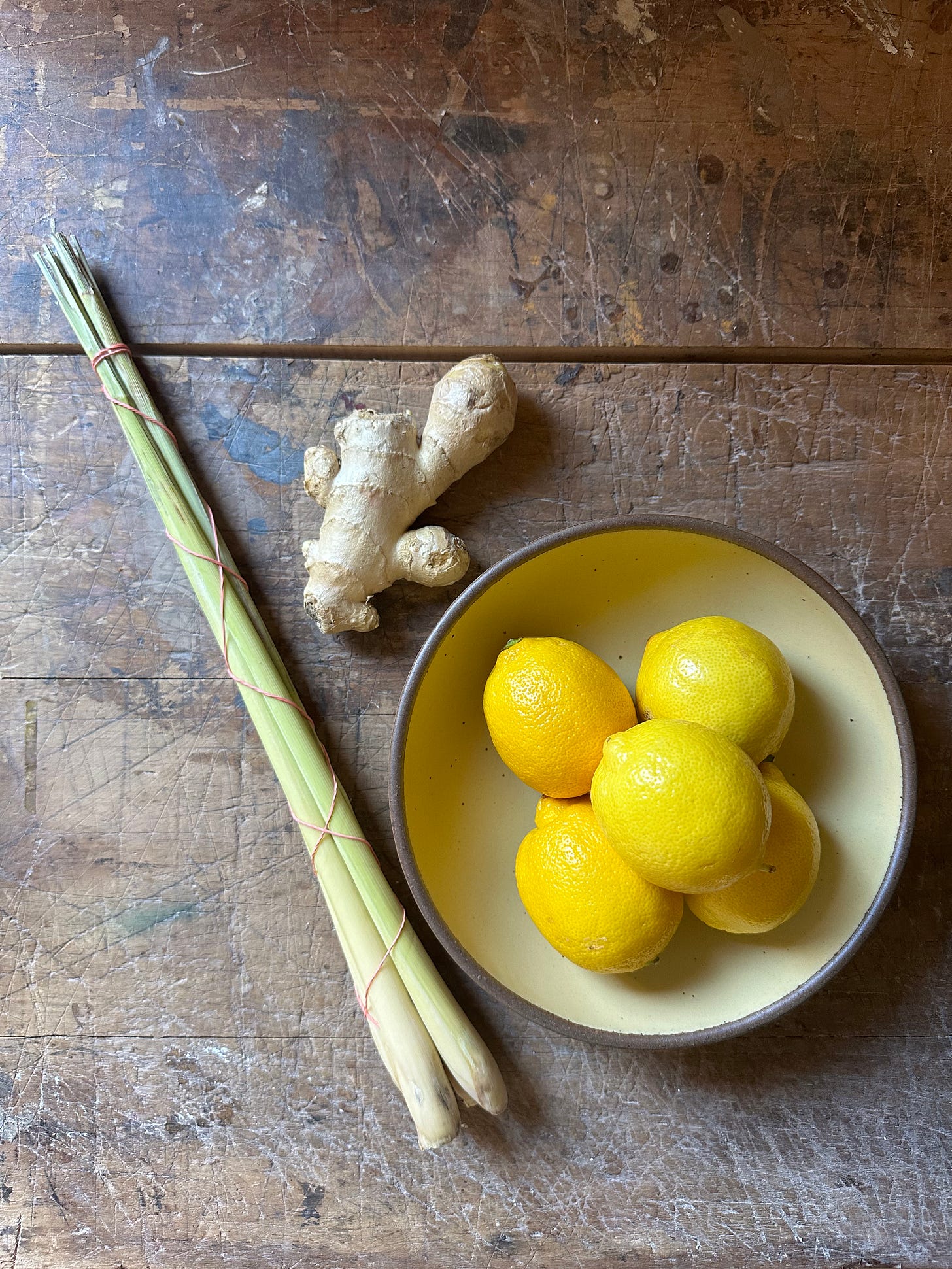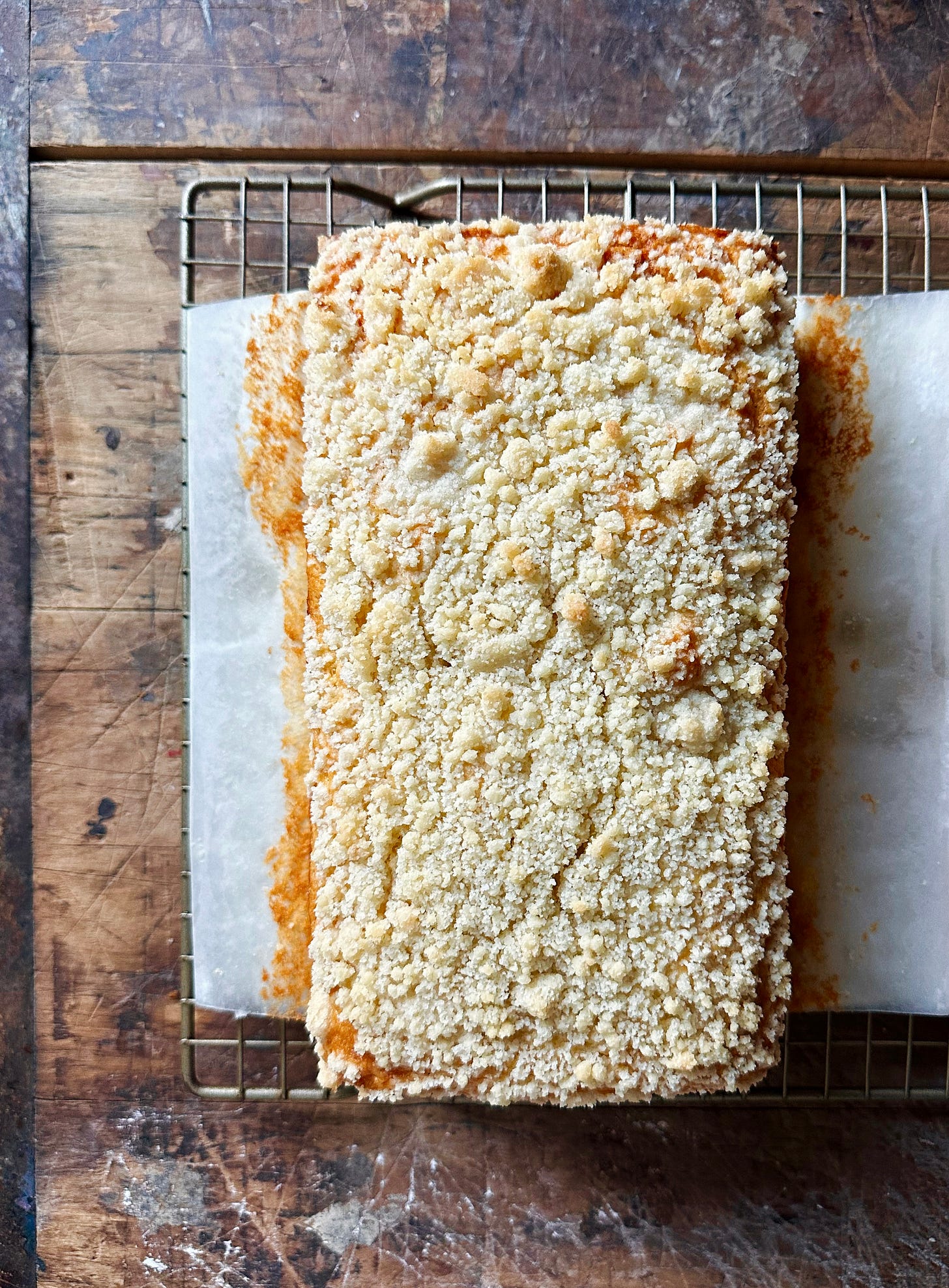Lemon, Ginger, & Lemongrass Crumble Cake
Spring is upon us! (hopefully) And this cake is here to help with the transition. I share some failures and walk through the roles that each ingredient plays in a cake. Enjoy!
We’re slowly inching toward spring. I can see it in the little green fingers of perennial bulbs reaching up from the flower beds throughout Brooklyn. Yesterday i even saw flowers. It feels too soon but you won’t catch me complaining.
I see the change in my baking habits as well. I’m reaching far less often for the usual suspects of fall/winter baking - cinnamon, clove, nutmeg - and instead I’ve started reaching for lighter and brighter flavors. This recipe came about because I wanted a cake that celebrated the blurred edges between seasons. It’s both a sendoff to the dried spice cabinet and a warm welcome to punchy fresh ginger root and late winter citrus.
As a kid I devoured sour candy. Anything coated in sugar and citric acid was an immediate “yes” from me. My all time favorite had to be Lemonheads. This candy is almost painfully sour when it first hits your tongue but as it dissolves it sweetens and there’s a nice floral lemon flavor hiding behind the near electric mouthfeel. Their season is pretty short but if you see Meyer lemons at the store, they’re the closest thing to that taste and the best to use for this recipe.
Meyer lemons originated in China and are believed to have come from a cross breeding between lemons and a mandarin/pomelo hybrid. While still acidic, they have a sweetness that is more prominent than a standard lemon. I find that even though Meyer lemons have thinner skin, the zest derived from them is more potent - which was just what I wanted.
My desire to pack this cake with as much of a citrus punch as possible was nearly its downfall though. I baked five different versions of this cake before I was able to dial in the properties I was looking for. It ended up being a great opportunity to examine why certain things work or don’t work in a typical cake recipe.
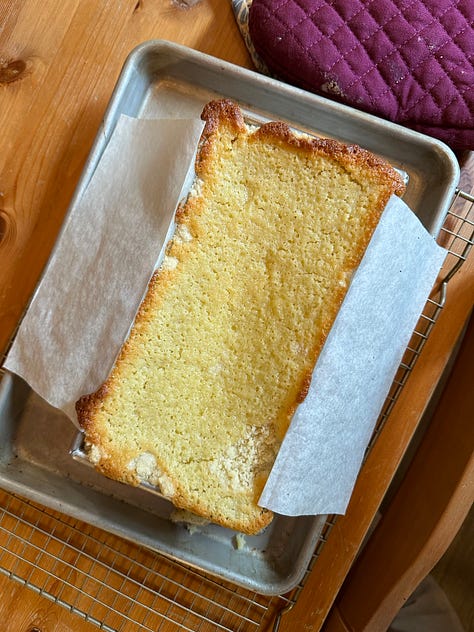
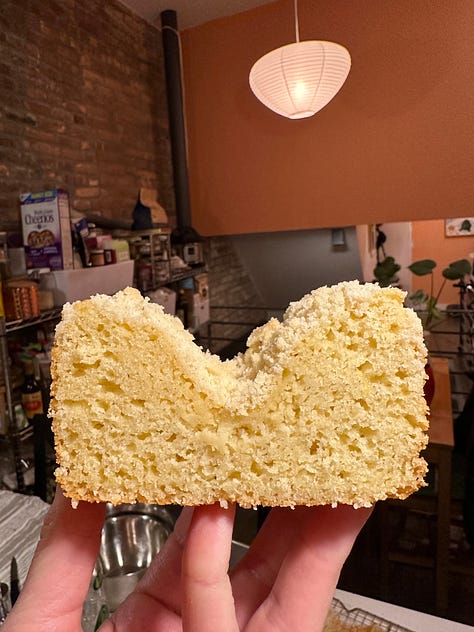
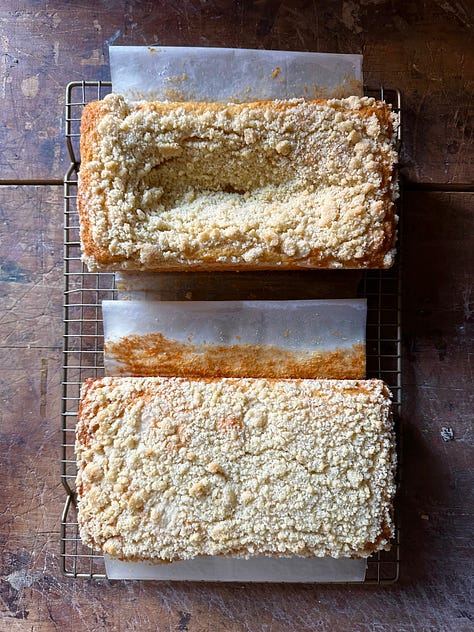
As A Matter Of Fat - Most cake recipes include some form of fat. That fat is usually in the form of butter or oil. When using butter there are a few ways to incorporate it into the other ingredients. You can mix the softened butter into the sugar, referred to as “creaming” or into the flour, referred to as “reverse creaming”. Another less common way but often seen in quick breads and muffins is to melt the butter and whisk/fold into the remaining wet ingredients. This method essentially treats melted butter like oil. While this technique is easy and fast, it often produces a denser outcome because you’re not incorporating air into the butter and as the cake cools the butter is returning its solid state. It’s a great technique when you want the flavor of butter and need to bake quickly without much concern for a lighter crumb/texture.
During my first couple of attempts at this cake, I experimented with using a mixture of butter and oil. Thinking the butter would provide richness and flavor while the oil would help keep the interior from being dry. In the end I opted for 100% olive oil because of the softness it brings to the cake and because of the time it saves. So often, simpler is better.
Gotta Blame It On My Juice, Baby - I wanted the first bite of this cake to feel almost like you were sinking your teeth into a wedge of lemon. There are three common ways to add citrus flavor/acidity to a cake - juice, zest, and extracts/citric acid. I knew right away that I didn’t want to call for lemon extracts or citric acid because these ingredients are a little more challenging for the average home baker to acquire. I love using citric acid in professional settings because it adds the acidity of citrus juice without the water. (citric acid is the key to a really zippy and creamy hummus that doesn’t taste diluted or lumpy in texture)
At one point, I tried to use 1/2 cup (112g) fresh lemon juice in this cake. The result was a very wet batter that couldn’t hold the weight of the crumble topping. It was beyond the land of moist and entering the territory of sopping wet. I lowered the amount of juice and opted for extra zest as the solution.
Dairy Queen - Besides the butter, additional dairy products like milk, yogurt, or sour cream are used in cakes to provide both fat and moisture. The liquid water found in dairy helps to hydrate the flour creating enough gluten for cakes to be structurally sound. The fat helps the cake stay softer for longer. An additional benefit to using dairy products like buttermilk, yogurt, or sour cream is that they each contain lactic acid which works to activate leaveners like baking soda and baking powder while also breaking down some of the protein in flour which creates a more tender finished product.
I opted for full fat Greek yogurt because it provides richness with less water due to it being strained. This allowed me to use more lemon juice and to not be too cautious incorporating fresh ingredients like ginger root and lemongrass which both bring additional juice to the mixture after being processed with the sugar.
All Together Now…
If you’ve read this far then you’re really invested in this cake and I appreciate you. In the end, through trial and error, a really delicious cake appeared. It’s packed with the flavors of lemon and ginger but pulled back enough to not leave your lips puckered for too long. It’s tender and moist without requiring a spoon and bib to eat and it features a sandy crumble topping that reminds me of the beach and provides a crunchy contrast to the soft cake that lies below.
A Note On Lemongrass - I could write an entire post on this ingredient. I first encountered it while cooking a Malaysian curry in graduate school and it’s been a lengthy and deep love affair ever since. I seek it out and use it any time I can. I even wear it as a fragrance at times. (shoutout to L’Occitane - the only reason you’ll catch me in a mall these days) That being said, I know that for many folks in the US, lemongrass can be difficult to find. Try searching in Asian/Southeast Asian grocers for the fresh or frozen varieties but know that if you can’t find any you can substitute additional fresh ginger root and still have a lovely cake.
Recipe
Lemon, Ginger, & Lemongrass Crumble Cake
Keep reading with a 7-day free trial
Subscribe to Save Me A Slice to keep reading this post and get 7 days of free access to the full post archives.


